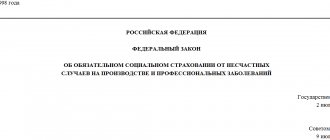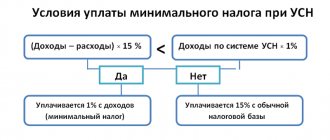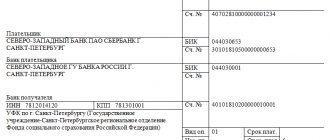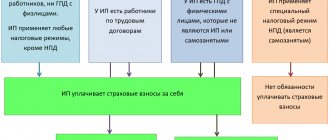A simplified taxation system is a great opportunity to reduce the tax burden for small businesses. Moreover, low rates are not the only benefit of the simplified tax system. Reducing the tax on the amount of insurance premiums transferred for employees or individual entrepreneurs for themselves allows for an additional reduction in payments to the budget. How to do this legally? We'll tell you everything in detail and with examples.
Input data
In this material we will look at a simple example to understand how an individual entrepreneur should act when calculating taxes and contributions . Our entrepreneur will meet the following criteria:
- Pays tax at a rate of 6% , that is, it uses the simplified tax system with the object’s income.
- Does not attract hired workers.
- Does not work with individuals, therefore does not use a cash register. The contractors of the individual entrepreneur are entrepreneurs and legal entities with whom he pays through a bank account.
What must be paid
An entrepreneur using the simplified tax system is exempt from paying many taxes:
- Personal income tax in relation to own income;
- VAT (with some exceptions, for example, on export transactions);
- Property tax applied when carrying out business activities (with the exception of real estate, which are taxed based on cadastral value).
The only tax that a simplified entrepreneur who works independently pays is the tax in connection with the application of the simplified tax system. In our case, this is 6% of the income received. The tax is paid throughout the year in advance payments :
- for the first quarter - no later than April 25;
- for half a year - no later than July 25;
- for 9 months - no later than October 25.
The final payment is made at the end of the tax period (year) until April 30 of the following year.
The rule applies: if the last day of the payment deadline falls on a weekend, then this deadline is postponed to the first working day.
There are also sectoral taxes that are paid when carrying out specific activities (for example, water tax, mineral extraction tax and others). Their tax under the simplified tax system does not replace them.
In addition to taxes, individual entrepreneurs are required to pay insurance contributions to the Pension and Medical Funds . Starting this year, the amounts of contributions have been fixed, whereas previously they were tied to the minimum wage. For 2021, the entrepreneur must pay for himself:
- Pension insurance contributions : From income up to 300 thousand rubles - 26,545 rubles. Payable by December 31, 2021.
- For income exceeding 300 thousand rubles - 1%. Payable by July 1, 2021. A maximum has been set equal to 8 times the amount of fixed contributions from paragraph 1. That is, the maximum individual entrepreneur will pay is 26,545 * 8 = 212,360 rubles.
Note! The above figures are current for 2018. Higher amounts of insurance premiums have been determined for 2021 and 2021 (Article 430 of the Tax Code).
conclusions
In conclusion, we can conclude that all organizations submitting updated declarations with a reduction in the amount of tax previously declared for payment should be prepared for a more thorough conduct by controllers of a repeated desk audit in relation to the declared adjustment with the provision of explanations and documents. If you are sure that everything is in order in your accounting department, feel free to exercise your right.
Do you want to reduce taxes? Get advice from a tax expert by phone 8
Accounting
In terms of accounting, everything is quite simple. An individual entrepreneur does not keep accounts and does not submit annual financial statements. However, he is required to keep tax records. For this purpose, the entrepreneur must fill out a book of income and expenses for entities using the simplified taxation system. In it, the entrepreneur records all his income transactions.
Expenses of an individual entrepreneur on the simplified tax system with the object “income” are not taken into account, therefore column 5 of Section I of the accounting book is not filled out. However, it is necessary to reflect the insurance premiums paid in the book. They are reflected in Section IV.
Using the book of income and expenses, the individual entrepreneur calculates the tax payable in the reporting period. Information is entered into the book based on an extract from the current account.
What is taxed on the simplified tax system?
First, a little theory. In the simplified system, there are two different objects of taxation:
- income;
- income reduced by expenses.
In the first case, income received (from the sale of goods, works, services, as well as some non-sales income) is taxed. Expenses, even those necessary for business, are not taken into account. The standard rate for simplified taxation system Income is 6%, but constituent entities of the Russian Federation have the right to reduce it to 1%.
In the second case, income before taxation is reduced by expenses: proven, economically justified and included in the list of Article 346.16 of the Tax Code of the Russian Federation. That is, the tax base is not all income, but the difference between income and expenses. The usual rate for this option of the simplified tax system is 15%, while many regions for some types of activities reduce it to 5%.
Tax calculation
Calculating the advance tax payment is not difficult. It is calculated according to the formula: Advance payment = Tax base * 6 / 100, where the tax base is equal to the entrepreneur’s income for the reporting period on an accrual basis.
For example, an individual entrepreneur earned (cumulative income):
- for the first quarter - 0 rubles;
- for the first half of the year - 20 thousand rubles;
- for 9 months - 130 thousand rubles;
- for the year - 295 thousand rubles.
Advance payments (before deduction of insurance premiums) will be:
- for the first half of the year - 20,000 * 6 / 100 = 1,200 rubles;
- for 9 months - 130,000 * 6 / 100 = 7,800 rubles;
- for the year - 295,000 * 6 / 100 = 17,700 rubles;
Further, the advance payment can be reduced by the amount of insurance premiums paid during the period. The reduction mechanism is discussed in detail below. In addition, the tax payment is subject to reduction by the amount of advance payments previously paid in the year for previous periods. The formula takes the form:
Payment amount for the period = Advance payment for the period - Amount of contributions paid in the period - Advance payment paid for previous periods of the year
What counts as income
In terms of income accounting, there are the following rules:
- Income is accounted for on a cash basis. This means that they are recognized on the date they are actually received. The individual entrepreneur from our example receives his income to the bank, therefore, they are recognized on the date of receipt of funds into his current account.
Note! This rule also applies to prepayments against future deliveries. The entrepreneur must include this amount in his income on the date of receipt of the advance payment. If the transaction does not take place, that is, the advance payment is returned, this operation is reflected in the book of income and expenses in the period when the return was actually made. It must be indicated with a minus sign. Accordingly, this amount will reduce taxable income.
- Some types of income are not included in the taxable base , namely: Amounts of loans and borrowings, as well as amounts of funds received to repay loans and borrowings.
- Amounts of income that are subject to other tax rates. This includes bond coupons, dividends and other types of income.
- Amounts of income that are taxed in accordance with other taxation regimes. Often an entrepreneur combines two systems, for example, simplified tax system and UTII or simplified tax system and patent.
- Amounts of funds that are not income. This includes, for example, funds for the return of defective goods, erroneously credited by the bank or amounts transferred by the counterparty.
The following table shows a fragment of the Book of Income and Expenses of our individual entrepreneur for the first half of the year.
Table 5. Example of filling out Section I of the Income and Expense Accounting Book
| No. | Date and number of the primary document | Contents of operation | Income taken into account when calculating the tax base | Expenses taken into account when calculating the tax base |
| 1 | 2 | 3 | 4 | 5 |
| 1 | 20.04.2018 № 1 | Payment under agreement dated April 20, 2018 No. 1 | 20000 | |
| 2 | 23.04.2018 № 2 | Prepayment under agreement dated April 23, 2018 No. 2 | 30000 | |
| 3 | 30.04.2018 № 3 | Refund of advance payment under agreement dated 04/23/2018 No. 2 | -30000 | |
| Total for the second quarter | 20000 | |||
| Total for the half year | 20000 |
How is the tax to be reduced reflected in the declaration under the simplified tax system?
In order for expenses allowed by law to be deducted from tax to be taken into account, they must be shown in the simplified declaration in a special section 2.1.1 for this purpose, in which the calculation is carried out for the object “income”.
For all the details on how to prepare a declaration, see our material “How to fill out a declaration using the simplified tax system.”
In lines 130–133 you need to write down only the amounts of calculated advances on an accrual basis for the year.
Lines 140–143 must include amounts actually paid to non-budgetary funds, sick leave payments, which are allowed as allowable expenses for tax deduction.
If there are employees, then lines 140–143 cannot be more than half of the corresponding lines 130–133. If the individual entrepreneur does not have employees, then in the case when contributions exceed the calculated tax, the data in these lines is equal to the amount of the collection to the budget.
Section 2.1.2 indicates the amount of the trade fee, which also leads to a reduction in the simplified tax system of 6 percent (clause 8 of Article 346.21 of the Tax Code of the Russian Federation), provided that the person is registered as a payer of this fee.
Calculation of insurance premiums
For the year in which the entrepreneur registered, he must pay contributions not in full, but in proportion to the number of days that he was considered an individual entrepreneur . Let's say it was entered into the register on April 16, 2021 . This means that in 2021 he is an entrepreneur for 8 full months and another 15 days of April. The calculation will be as follows:
- Pension contributions from income up to 300 thousand rubles:
- 26545 / 12 * 8 = 17696.67 rubles - for 8 months of 2021;
- 26545 / 12 / 30 * 15 = 1106.04 rubles - for 15 days of April;
- 17696.67 + 1106.04 = 18802.71 - total in the Pension Fund.
- Medical fees:
- 5840 / 12 * 8 = 3893.33 rubles - for 8 months of 2021;
- 5840 / 12 / 30 * 15 = 243.33 rubles - for 15 days of April;
- 3893.33 + 243.33 = 4136.66 - total in the Compulsory Medical Insurance Fund.
In total, an individual entrepreneur registered on April 16, 2021 must pay up to 300 thousand contributions in the amount of 18,802.71 + 4,136.66 = 22,939.37 rubles .
Features of paying insurance premiums to deduct their amount from advance payments
An individual entrepreneur without employees has the right to reduce advance tax payments by the amount of insurance premiums that he paid in the tax (reporting) period . Moreover, the tax amount can be reduced down to zero. In other words, if during the reporting period the entrepreneur’s income was small, and the contributions paid completely covered it, he may not pay tax.
The rules for reducing the advance payment are as follows:
- It is reduced within the calculated amount . That is, if the contributions paid are greater than the amount of the advance payment, the tax cannot go negative. Let’s say the advance payment is 15 thousand rubles, and the amount of contributions paid is 17 thousand rubles. The payment will decrease by 15 thousand and will be equal to zero, and the “extra” 2 thousand rubles will not be transferred and will not be compensated.
- It is reduced by the amount actually paid during that period , not calculated for the period. It does not matter for what period the tax was paid - for the current period (advance payment), for the tax year (surcharge on income over 300 thousand rubles) or for previous years (payment of debt). For example, in May 2018, an entrepreneur made an additional tax payment for 2021 on income exceeding 300 thousand rubles. By this amount, the entrepreneur will be able to reduce the advance tax payment for the first half of 2018.
Let's look at how paying contributions affects the amount of the advance payment. 20,000 rubles in April . Let's assume that he doesn't expect more income for the first half of the year. The amount of the advance tax payment for the tax for the first half of the year will be 20,000 / 100 * 6 = 1,200 rubles.
Above, we calculated that by the end of the year the individual entrepreneur must pay 22,939.37 rubles in insurance premiums. Our entrepreneur decided in April to pay 1,200 rubles towards contributions, thereby reducing the amount of the advance tax payment to zero.
Now let’s say that by the end of the summer the business of the individual entrepreneur went uphill and he managed to earn money every month from August to December. At the same time, he paid the remaining amount of insurance premiums in equal installments every month (except for April). The data is presented in Table 1.
Table 1. Income and contributions of individual entrepreneurs by month
| Month | Income | Paid dues |
| April | 20 000 | 1 200 |
| May | — | 2 718 |
| June | — | 2 718 |
| Total for six months | 20 000 | 6 636 |
| July | — | 2 718 |
| August | 50 000 | 2 718 |
| September | 60 000 | 2 718 |
| Total for 9 months | 130 000 | 14 790 |
| October | 40 000 | 2 718 |
| november | 45 000 | 2 718 |
| December | 80 000 | 2 714 |
| Total for the year | 295 000 | 22 940 |
In Table 2, individual entrepreneurs’ income, advance tax payments and contributions paid are presented as a cumulative total.
Table 2. Income, contributions and tax amounts by period (cumulative total)
| Period | Income | Advance tax payment (6%) | Actual contributions paid | Tax payment for the period taking into account contributions |
| I quarter | — | — | — | — |
| Half year | 20 000 | 1 200 | 6636* | 0 |
| 9 months | 130 000 | 7 800 | 14790* | 0 |
| Year | 295 000 | 17700 | 22940* | 0 |
*The amount of contributions paid exceeds the amount of the advance tax payment.
Now let's see what would happen if the individual entrepreneur did not pay contributions from May to August, deciding to leave them at the end of the year. The calculation results are in Table 3.
Table 3. Other procedure for paying contributions
| Month | Income | Paid dues |
| April | 20 000 | 1 200 |
| May | — | — |
| June | — | — |
| Total for six months | 20 000 | 1 200 |
| July | — | — |
| August | 50 000 | — |
| September | 60 000 | 5 000 |
| Total for 9 months | 130 000 | 6 200 |
| October | 40 000 | 5 000 |
| november | 45 000 | 5 000 |
| December | 80 000 | 6 740 |
| Total for the year | 295 000 | 22940 |
Cumulative data and advance tax amounts are in Table 4.
Table 4. Income, contributions and tax amounts by period (cumulative total)
| Period | Income | Advance tax payment | Paid dues | Payment amount for the period |
| I quarter | — | — | — | — |
| Half year | 20 000 | 1 200 | 1 200* | 0 |
| 9 months | 130 000 | 7 800 | 6200** | 400 (7800—6200-1200) |
| Year | 295 000 | 17700 | 22940* | 0 |
*The amount of contributions paid exceeds the amount of the advance tax payment.
**The amount of contributions paid is less than the amount of the advance tax payment.
This table shows that the total amount of contributions for the year exceeded the amount of tax. However, over the 9-month period, the individual entrepreneur received tax due, since the contributions at that time were paid less than the amount of the advance payment.
Nuances of reducing the “simplified” tax
All questions that, although not often, may arise when applying a deduction under the simplified “income” taxation system are set out in the continuation of the article.
From it you can find out what to do if you became an employer in the middle of the year, or vice versa, everyone was fired, for example, after the New Year holidays, as well as what to do if the only employee is on maternity leave, and other useful tips from the category “What to do?” .
Continuation..
Legislative foundation
- pp. 1 - 3 clause 3.1 art. 346.21 of the Tax Code of the Russian Federation (composition of deductions for individual entrepreneurs)
- para. 6 clause 3.1 art. 346.21 of the Tax Code of the Russian Federation (composition of deductions for individual entrepreneurs without employees)
- pp. 1 clause 3.1 art. 346.21 of the Tax Code of the Russian Federation (tax is reduced by contributions paid in the reporting period)
- para. 5 clause 3.1 art. 346.21 (Individual employers can reduce the tax by no more than half)
- para. 5 and 6 clause 3.1 art. 346.21 Tax Code of the Russian Federation, clause 3.1 art. 346.21 of the Tax Code of the Russian Federation (individual entrepreneurs without employees reduces the tax without a limit of 50%), Letters of the Ministry of Finance of Russia dated 09/01/2014 N 03-11-09/43646, dated 05/26/2014 N 03-11-11/24975, dated 04/07/2014 N 03-11-11/15344
- pp. 1 clause 3.1 art. 346.21 of the Tax Code of the Russian Federation (individual employers include contributions for themselves in deductions)
- pp. 2 clause 3.1 art. 346.21 of the Tax Code of the Russian Federation (reduction of tax on the amount of temporary disability benefits), Letters of the Ministry of Finance of Russia dated 04/11/2013 N 03-11-06/2/12039, dated October 20, 2006 No. 03-11-04/2/216
- Art. 7 of Law No. 255-FZ of December 29, 2006 (employer’s additional payment up to average earnings during sick leave is not a benefit (hence, is not included in the deduction under the simplified tax system))
- pp. 3 clause 3.1 art. 346.21 Tax Code of the Russian Federation (reduction of tax on payments under insurance contracts)
- Letters of the Ministry of Finance of Russia dated 01.09.2006 N 03-11-04/2/181, Federal Tax Service of Russia for Moscow dated 20.01.2009 N 19-11/003082 (supporting documents for reducing tax on the amount of temporary disability benefits)
{yandex_ads_article}
Payment of taxes and contributions
An individual entrepreneur pays all payments for himself according to the details of the tax office . To generate a payment invoice, you can use the official service of the Federal Tax Service. The first thing you need to know from the details is the budget classification code. Using it, the service can independently determine the type and name of payment. The individual entrepreneur must have all other details in the documents from the tax office and the Pension Fund.
Entrepreneurs on the simplified tax system of 6% should use the following codes (2018):
- for tax payment - KBK 182 10500 110;
- to pay contributions to the Pension Fund - 182 10210 160;
- to pay contributions to the Compulsory Medical Insurance Fund - 182 10213 160.
The generated payment order can be taken to the bank or used as a template for filling out a payment order in Internet banking.






